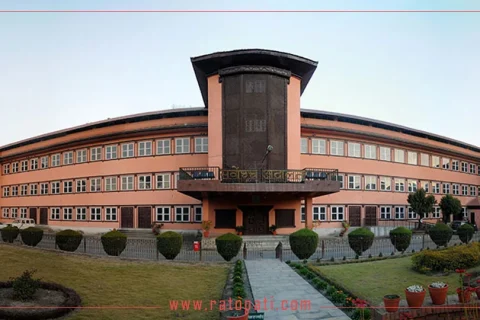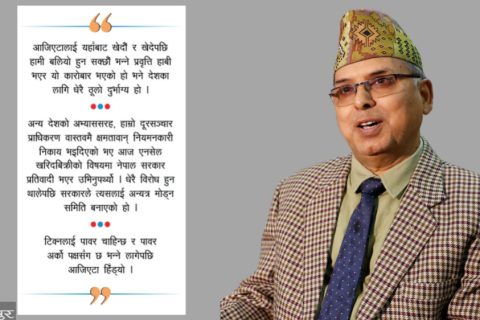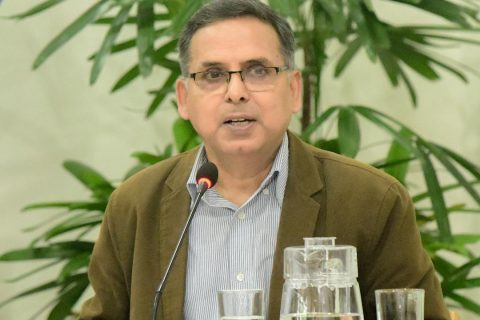As it stands now, the education system of the country is headed down a dangerously narrow path for the future. Overemphasis on occupational and professional studies, without addressing the gaps in liberal arts and many modern subjects will hurt Nepal’s national aspirations for the nation building. This dismissal of broad-based learning comes from a fundamental misreading of the requirements of building a nation. A new liberal arts university in Nepal is therefore the need of our country’s growth.
Those within Nepal and the diaspora abroad have frequently discussed Nepal’s needs for a high quality liberal arts university. Recently, such discussions to establish the University of Nepal (UoN), the proposed name at this stage, in Gaidakot have started to take a shape. The location of the university is also being finalized in order to create the space for long-term planning, strategies and investment.
It is now recognized that building Nepal requires a strong liberal arts base as much as other technical or professional disciplines. For this purpose, it is accepted that in both liberal arts teaching and research, where excellence must go hand in hand, the nexus with the local communities, and a desirable social outcome, must also be clearly established. Additionally, it also suggests that there are strong links between academic success and success in broadening the university’s role in a wider social and economic agenda. There are indications that such a dream of a fully-fledged university is about to be realized.
I. Product differentiation
There are already 11 universities in Nepal. The Tribhuvan University (TU) established in 1959 is the first and the biggest public university in Nepal in terms of size, academic disciplines and levels of higher education, research, and student enrollment. It grew as an umbrella university, establishing schools and campuses as its satellites throughout the country and in all areas of learning, including in humanities, management, law, education, fine arts, agriculture, forestry, science and technology. However, liberal arts specialization has never been its sole thrust. While the vision was of a liberal arts education, the direction was gradually lost.
In 1986, almost after 27 years, the Nepal Sanskrit University (formerly, the Mahendra Sanskrit University) was established for the study of the Sanskrit language and its accompanying knowledge heritage since the dawn of the Nepali civilization. Its focus was on Sanskrit, which remains one special liberal arts area in Nepal. This followed the establishment of the Kathmandu University (KU) in Dhulikhel at the nongovernmental level, with an initial concentration in science, engineering and medicine. Later, it started expanding into other nontechnical subjects, while always emphasizing quality education and research. On its 27th year, KU is invariably the first choice of any student who wants to study in Nepal and can afford its entrance exams and programme fees. Yet, although the current management remains competitive in technical areas, KU is not a university that has a long-term perspective on liberal arts.
Two years after the establishment of the KU, the government established the Purbanchal University, a public university in Biratnagar, with no particular academic focus. Even in the formative years, the considerations were more political than academic. The new University had just inherited the property and infrastructure of the TU and continued with the existing legacy and general features of higher education in Nepal. The Pokhara University was established in 1997 as Nepal’s fifth university. Later, the Far-western University came into existence in 2010, and the Mid Western University was established as a new state-run university in Surkhet on the same year. None of these universities embark on any new discipline or educational territory. Their advantages were only that they were targeted to a given geographical areas, and their small management team were supposed to run efficiently and without bureaucratic features that became integral to TU’s proceedings in the course of its development. Still, liberal arts have not received the focus that it deserved in Nepal’s context.
This same year, in 2010, the Agriculture and Forestry University (AFU) was established in Chitwan through the merging of two of TU’s constituent campuses: the Rampur Agriculture Campus of the Institute of Agriculture and Animal Science and the Forestry Campus of the Institute of Forestry in Hetauda, Makwanpur. These campuses focused on the crucial areas of Nepal’s subsistence economy, because they were intended to prepare technical graduates to support Nepal’s agriculture and forestry development plans. They performed well in the beginning, but gradually, became average institutions, losing their cuff and vision. The value added for the new university is open to question.
The Lumbini Bouddha University, established in 2004, is another landmark. It was to concentrate on Buddhist studies and has materialized with a broad international vision. It is still struggling with teaching-learning and research in the areas of Buddhist philosophy, literature, education, Buddhist history, archaeology and culture to inspire shanti, bandhutwa, maitri and sadbhav (peace, empathy, friendship and compassion). In order to make its offerings marketable, recently, the University is embarking on interdisciplinary studies that secure some space for Buddhist studies as well. It has no broad agenda for liberal arts studies at this stage.
After 12 years, again, the Nepal Open University was established in 2016, as another landmark, heralding an open-door academic policy and employing modern teaching methods, such as open supported learning or distance education. The University offers flexible student-teacher relationships, allowing students to fit their learning around their work and home lives. In particular, students usually set their own pace of study, decide on when and where to study, and face lower costs for distance learning courses than for a full-time degree. The Nepal Open University has no specific commitment to the liberal arts. Additionally, the Rajarshi Janak University was founded in October 2017. Because of its formative stage, it is unclear how the University wants to emerge academically. Its enabling law does not give it any special features other than those akin to TU.
Recently, the government has registered a new bill in the Parliament Secretariat to establish the Madan Bhandari University of Science and Technology. It intends to offer a wide range of streams, from science and technology to humanities, and is supposed to be based in Chitlang of the Makwanpur district. It has good prospects, because it is the first university in Nepal’s history to distance itself from the government and intends to be operated by a board of trustees, which will supposedly ensure that there is quality control and efficient governance. Besides, the Chinese government is also supporting it as a bilateral project with Nepal. It is yet to be seen what additional competitive advantages it will have over other universities. The emphasis on science and technology is more than clear.
Apart from these institutions, Nepal has many other higher institutions of learning, but none with a liberal arts perspective.
II. Liberal arts as lost horizon
From day one, when the Tribhuvan University was established 61 years ago, it started with liberal arts, and it is in this area in which Nepal made significant strides. Its excellence in Nepali, English, economics, political science, geography, history, culture, and many similar disciplines enabled graduates to know their country, civilization and contribute to its development process. The TU’s quality of education generally improved consistently, until 1990. Its expansion and development as the only university in the country, with sprawling faculties, offerings and campuses, has been quite encouraging for sometime even after 1990. With the restoration of democracy that year, the openness gave TU a further boost but added political challenges, including non-academic interferences on the part of the government.
After each successive government, and ensuing political instability, TU suffered in terms of its autonomy, decision-making power, academic focus and quality of leadership. Gradually, the leadership positions in the University started being offered to political nominees, rather than leading academic figures, from whom the ruling party received support as insiders. The selection process of the officials, including of the vice chancellor, affected the mental makeup of the whole organization. As part of the governmental coalition culture, commensurate with the division of portfolios at the cabinet level, the portfolios at the university level were also divided between major political stakeholders, ignoring their capacity and intellectual credibility. Appointment of faculties and management of schools and campuses on partisan considerations produced many negative trends. The perspective of quality in offering academic leadership thus was pushed to the back burner.
The TU’s vastness required efficient management, which was not possible in the given situation. To make the university system workable, in this mediocre environment, professor and student unions were allowed, and they pervaded the scenario, creating a trade union culture in the University. Unionization of the faculties and the students could not have a better effect on the already deteriorating academic environment. While the quality of the academics in this scenario was bound to suffer, the thrust and autonomy of the University started to erode. All universities in Nepal, to a different degree, have suffered from the same dynastic fate. The liberal arts component in their offerings would have the same fate despite the fact that technical education (engineering, medicine, agriculture, etc) in the country is statistically in a comparatively better position.
At present, the country is being run at most fronts (civil, judicial, military and political, for example) by the graduates who were produced during TU’s declining years. To many, this explains the pathology of ailing Nepal. The worst effect of the change is on liberal arts, although there are areas of improvement everywhere.
III. A new university with a different touch
With this context in mind, the civil society promoters of the University of Nepal felt that the need for a liberal arts education in Nepal was vital. Thus, the University that is to be established in the Gaidakot Municipality has a declared objective of concentrating on liberal arts with an interdisciplinary approach.
Even though UoN will be a public university, it will be under the supervision of a board of trustees, not the government, following the model being established by the Madan Bhandari University of Science and Technology. A combination of national and international experts, who have already joined hands, will form the core academic faculties of the University and its departments. The University will have special arrangements for hiring and supporting quality professors/faculty from Nepal and abroad, on different modalities, making it a national hub for Nepalese international studies. Quality academic support services and ample staff (academic advisors, tutors, and teaching assistants, among others) will be available to students. Research opportunities and funding for all departments and faculties will be secured through international collaboration. Joint research on Nepalese themes will be promoted.
The Nepalese diaspora in the academic and professional sectors in Europe, North America and Australia will be mobilized as visiting faculties and state of the art resource persons for the University. Similarly, the University will coordinate with the American, British and Australian diaspora in Nepal, including experts working in Nepal from abroad, to utilize their talents in international and Nepalese affairs. The high profile board of trustee of the University, free of financial benefits from the institution, will help the management to produce the best results that the country needs in this area.
The plan is to develop the University within one campus, or within the campuses in the same locality, which enables the sharing of resources, and development of Gaidakot as a knowledge city. From day one, the University will work closely with the communities and establish a community outreach approach in the process of developing the institution. A wide range of courses will be offered that will aim to fill the quality gaps in liberal arts education in the country. The University will encourage professional bodies to come forward and establish think tanks sharing the forum with academics and the civil society experts. Reasonable rates of tuition in relation to quality of courses/faculty will be enforced. Opportunities to receive financial aid will exist for all quality students. An extensive library and computing facilities will be available. A provision for on/off campus residences and positive residence life programs will be maintained. Health and wellness supports (counseling, medical services, and gym) will be a part of the campus.
The terms “liberal arts” is a collective expression for the contents as well the approach. It is clear that some disciplines, like native languages, literatures, history, religions, cultures, fine arts, music, English, mathematics, physical sciences, economics, geography, political science, legal studies, philosophy, lifestyle and the kind of education that liberates, emancipates or enlarges the Nepalese mind and our nation-building process are very important for Nepal. Public policy is another such area upon which it is already too late to embark. A liberal arts education and an interdisciplinary approach provide students with the opportunity to practice free-thinking. It teaches them how to think critically, communicate clearly, analyze and solve complex problems, appreciate others, understand the physical world and be prepared to learn continuously, so they can collaborate with others and on their own to meet the challenges of the future.
As it stands now, the education system of the country is headed down a dangerously narrow path for the future. Overemphasis on occupational and professional studies, without addressing the gaps in liberal arts and many modern subjects, like artificial intelligence, sociology and anthology, will hurt Nepal’s national aspirations for the nation building. This dismissal of broad-based learning comes from a fundamental misreading of the requirements of building a nation. Over the years, the de-emphasis in humanities and low profiling of degrees like arts, history or the fields of music, theater, dance and others have unfortunately been perceived as expensive luxuries for Nepal. The stakes could not be higher to a country that has needs to raise its intellectual capacity and deal with many socio-economic and political challenges. They require the intent to combine practical, concrete information, like data and statistics, with theoretical knowledge, like ethics and philosophy. A firm national footing on liberal arts will create a broad-based agenda for our change in all directions.
All universities of Nepal so far have liberal arts subjects in their academic programmes and research. The distinctness on the part of the University of Nepal is not only the value of the content that will be taught, but also in the approach and mode of teaching and in the intellectual skills that are gained by learning how to think systematically and rigorously. These intellectual skills include how to assess assumptions, develop strategies from problem solving, test ideas against evidence, use reason to grapple with information to come to new conclusions and develop courses of action to pursue those conclusions. Teaching these subjects within a liberal environment framework ensures a greater value of learning. The existing universities of Nepal, due to their intrinsic problems, may not be able to embark on this national challenge.
Education on the liberal model contributes to intellectual development, philosophical diversity and aim at nation building based on liberation. A new liberal arts university is therefore the need of our growing nation. Nepalese civil society team is prepared to take on the challenges of fundraising to help materialize this dream.







